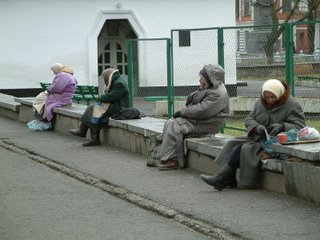Found the art of Pilar Ovalle at the Museo de Bellas Artes in Santiago, Chile in April of 2006. In my opinion one of the best sculptures I have experience. Her sculpture portraits the spirit of her media the trees. It is so easy to fall in love with the artist through her work.


Above photo found at
www.aenoticiasl.pr.gov.br.
Interview below found at
www.plagio.cl "Yo no trabajo para los premios, hago lo que hago porque me apasiona"
por Carolina Mosso E. 06.06.2006
Aquí hay mucho amor, era una de las frases que más se repetía en el libro de comentarios de Wenu Mamül, Maderas del Cielo, la exposición que desde el 13 de enero se instaló en el ala norte del Museo de Bellas Artes. Y aunque no fue esta la muestra la que le valió a Pilar Ovalle la nominación al Altazor de este año (fue “Travesías”, en la Galería Isabel Aninat), esta escultora de 35 años dice estar “sorprendida y feliz” por el recibimiento de la exposición que, tras un rotundo éxito en el Museo Óscar Niemeyer de Curitiba, Brasil, fue finalmente traída a nuestro país, para permanecer durante casi tres meses en el Museo de Bellas Artes.
"Pilar Ovalle transmite la gran alegría que se siente al encontrar un pedazo de árbol superviviente, ya informe y abstracto, a la obra que emerge de su hallazgo. No busca formas reconocibles; busca inspiraciones ocultas que se manifiestan al azar, con el tiempo, y reflexión. Busca fragmentos de alma, trozos de espíritu, y con sumo cuidado y respeto, los transforma en imágenes sugerentes, formas que son aleaciones de lo añejo con lo actual. Crea una visión fresca de la majestuosidad del árbol milenario." Esas fueron las palabras que usó el destacado curador chileno Edward Shaw para describir la última exposición de Pilar Ovalle, "Wenu Mamül, Maderas del Cielo".
Y es que el trabajo de esta escultora de 35 años y voz pausada, no deja indiferente. Nominada por tercera vez al Altazor en la categoría Escultura (2002, 2004 y ahora, 2006), Pilar Ovalle -dicen los críticos- en su técnica más cercana a lo constructivista y geométrico logra hacer permanecer la gestualidad y espontaneidad en sus figuras, e imprimirles una potente intención de corporalidad e incluso movimiento.
Además, la obra de esta escultora (quien ha desarrollado una sólida y consistente trayectoria artística desde su primera exposición individual en la Galería de Isabel Aninat en 1994), ha sido catalogada como un arte "ordenado, pulcro, que agrada por la formalidad del oficio", además de haber dicho de ella que se trata de una artista "valiosa y valiente" al atreverse con un gran formato, "que no es fácil en para una escultora joven". Tras haber obtenido dos veces la beca del Fondart (por "Esculturas con despunte en madera" y "Esculturas dobladas con técnicas chilotas"), el 2004 gana el primer lugar en el concurso de Esculturas de los países del MERCOSUR, lo que más tarde le permitió dar a conocer su obra en la ciudad de Curitiba, en Brasil.
En las formas y texturas de cada una de las piezas, cuenta Ovalle, se tejen historias sociales y personales: el reencuentro con la tierra, la búsqueda de lo espiritual y divino, la intuición de lo antiguo revivido en lo moderno. Y es justamente a partir de cortes y ensambles a los trozos de madera nativa que ella misma ha recolectado (roble, pino, raulí, mañío, coihue e incluso alerce), que la artista crea figuras antropomorfas y anecdóticas. En esos trozos, dice la escultora, pretende otorgarle un aspecto vital a sus obras, desarrollando un constante juego de imperfecciones con las texturas, nudos y vetas de la madera. Una técnica que, confiesa, ha ido perfeccionando tras los años, pero que aún la mantiene encuadrada en lo literal de la destreza.
Cuéntame cómo es tu relación con la madera ¿A partir de qué momento nace esta cercanía?
La madera la encontré casualmente. Tenía que hacer un trabajo en la universidad con formato de material libre, y estaba buscando un material. Yo antes trabajaba con papel, con cartón, y hacía esculturas como maqueta… bastante parecidas a mis esculturas de ahora, pero en papel. Y me encontré con la madera cuando botaron unos árboles en la Costanera y las llevé a mi taller. Me costó harto, fue súper difícil, porque me gustaba el material, pero no tenía idea de cómo empezar: cómo cortar, cómo ensamblar.
Fue como un enamoramiento con la madera, y a partir de eso me dije: "tengo que aprender a trabajarla y meterme fuerte en el oficio". Ahí empecé a ver, a estudiar todo lo relacionado con carpintería. De a poco me fui metiendo, y ya llevo 15 años trabajando con esa técnica.
Pero ¿te has hecho asesorar con gente que conoce más el material, has tomado cursos para especializar tu técnica?
No, soy autodidacta. Estudié Arte en el Instituto de Arte Contemporáneo Mulato Gil (1989) y después hice Escultura en la Católica (1993), pero hice fierro, entonces madera es algo que he trabajado e investigado sola. Me gusta mucho investigar y, en realidad en todas las cosas que he investigado me meto, estudio y trabajo harto, para poder desarrollar el mecanismo y lograr sentirme más libre en la creación.
Ya teniendo la técnica, ¿cómo se gestó concretamente esta muestra?, ¿a partir de qué nació?
La verdad es que ésta es como la mitad de otra muestra que hice en Brasil. Me gané una beca para exponer en el Museo Óscar Niemeyer 24 obras. Imagínate que mi sala era de dos mil metros cuadrados…
Y el trabajo fue muy bien acogido, a pesar de que en Brasil hay mucha madera y la trabajan muy bien. A nivel de crítica, mi exposición salió muy bien evaluada e incluso se decía que no se había visto nada similar. Entonces obviamente para mí fue sumamente positivo exponer allá, porque a partir de eso el Museo Niemeyer quiso que yo expusiera acá en el Bellas Artes. Y ya en Chile, la muestra que monté expuse trabajos de usé en Curitiba y también otras que había trabajado durante los últimos cuatro años, aunque la mayoría son de los últimos dos.
¿A qué remite el nombre de tu exposición?
Wenu Mamül viene del mapudungún, "maderas del cielo". "Maderas", porque la mayoría vienen de esa zona: el canelo, los cipreses, el alerce; y "del cielo", porque es el sentido que yo le doy al arte, que está relacionado con ideas más espirituales, es mi búsqueda interior…
En muchas culturas, por ejemplo en la misma mapuche, es muy importante la figura del árbol. ¿Cuál es tu intención en el desarrollo de tu técnica? ¿Pretendes hacer un vuelco a través de esta obra concreta? ¿Existe algún guiño ecologista, por ejemplo, en tu exposición?
No, yo creo que mi única parte ecológica (que también sale al azar) es trabajar con pedazos desechados, y no cortar árboles. En las barracas botan pedazos de madera, en las mismas mueblerías… yo trabajo con todas las sobras, incluso las que yo boto, las reutilizo. Eso podría decirse que es lo más cercano la ecología que, aunque me interesa mucho, siento que no trabajo para eso. No es ese el principio que mueve mi trabajo.
Sin embargo, sí siento que el árbol es muy importante como iconografía en nuestra vida, porque es un elemento de la naturaleza muy simbólico, que está muy cargado y por eso mismo creo que integré estas concepciones en mi obra.
En el video que se muestra en tu exposición, que da a conocer tu técnica y cómo evolucionó tu creación, dices que crees que la madera es el electo más parecido a la piel humana. Me gustaría que me explicaras un poco a qué te refieres con eso.
Tiene que ver con que, cuando trabajo, la siento como viva, porque realmente lo está...la madera es viva.
Y digo que es lo más parecido a la piel humana porque tiene temperatura y textura, no es fría como el fierro. Por ejemplo, me pasa al trabajar, y observo cómo las vetas son las huellas de nuestra piel, la salvia es la sangre… y me doy cuenta de que el árbol está vivo: uno le hace cortes y sale líquido, entonces hay algo que está relacionado muy fuerte con el ser humano. La madera, es la piel humana del árbol.
Por lo mismo es más difícil como material, me imagino, porque es más impredecible en los cortes…
Cualquier oficio sin conocimiento es difícil, pero una vez que se adquiere, ya no se trata de la técnica, sino de buscar la representación.
¿Y sientes que ha habido una evolución en tu obra?
Sí, sí, sí. Siento que me he desprendido de una forma más literaria, de la cosa más anecdótica. Y mi búsqueda va por ese lado. Quiero soltarme más en la expresión.
Justamente te iba a comentar que muchas de tus obras son muy anecdóticas, antropomórfica ¿Fue esa tu intención en esta muestra?
Evocar está relacionado para mí con querer transmitir no tan literalmente, y a lo mejor no es lo que tengo logrado en un 100% pero sí es para donde voy, lo que me interesa. El arte me hace sentido cuando son evocaciones, porque no hay escritura pero sí expresiones que tienen que evocar situaciones, emociones, ideas. Entonces todas estas ideas, que no se pueden expresar en la obra materialmente, en la evocación se pueden transmitir. Si llegan al espectador, esa es parte de la creación, la capacidad de evocar.
¿Y sientes que vas por buen camino en esta búsqueda? ¿Sientes que tu mayor "pero" está en la técnica, por ejemplo?
No, creo que la técnica ya no hay que profundizarla más porque se transforma en algo muy mecánico… al contrario, creo que tengo que soltarme más. Creo que he estado muy abocada a la técnica, por una cosa perfeccionista que tengo (que no sé si es bueno, pero lo tengo), y por amor al oficio, porque es algo que amo mucho. Pero ahora estoy tratando de integrar más todo lo que es poesía en el arte.
Cambiando de tema, para la recolección de maderas, ibas al sur a buscarlas… ¿siempre has trabajado de esta manera?
Sí. Yo trabajo siempre con madera encontrada. Ya sea con pedazos de madera encontrada en el sur, en el bosque, en el lago, o de las otras maderas, las nuevas, que vienen en basa. Trabajo con maderas que no están disponibles para muebles o para casas, porque tienen nudos, porque están dobladas. Y justamente yo trabajo con las imperfecciones, me gusta trabajar con los desechos y arreglar. La construcción a través de lo que es la transformación: de lo que está botado, los pedazos en desuso… eso es lo que me motiva y me inquieta.
¿Cómo tomaste tu nominación al Altazor?
Bien, he sido tres veces nominada al Altazor y me parece que la nominación es ya un premio. De ahí a salir… igual es fantástico salir, pero igualmente me siento súper agradecida de mis pares, porque siento que me valoran harto.
¿Y sientes alguna diferencia con respecto a otros años?
No, para nada. La alegría y agradecimientos son los mismos y todo sigue igual. Porque yo no trabajo para los premios, hago lo que hago porque me apasiona.
¿Tienes otros proyectos en mente?
Estoy tratando de ordenarme un poco. He tenido harto trabajo estos últimos años y tengo en mente muchas cosas pero todavía no las he desarrollado, porque todavía tengo que hacer cambios en mi taller, tengo que hacer cambios en mi manera de trabajar, así es que estoy ordenándome mentalmente para ver cómo vuelvo a trabajar.
Y llevar las muestras a otros países…
Voy a San Francisco ahora en mayo y voy a conversar con galerías para ver algunas ofertas que hay. Voy a ver si sale algo.
Quiero que me relates un poco la sensación de verte en el Bellas Artes con esta muestra. Ha sido un proceso largo, tú tienes 35 años, y hay muchos artistas que sueñan con lo que tú has logrado en tan poco tiempo (incluyendo tu nominación este año a los Altazor)
Bueno, es cierto que soy súper joven para estar en el museo. He tenido una carrera muy rápida, he podido exponer mucho, he tenido bastante reconocimiento y eso es muy gratificante, porque te ha e avanzar, genera apoyo. Entonces ha sido muy, muy bonito.
Mi obra en el museo es un espacio que tiene una carga fuerte, porque es un lugar bien tradicional. Yo siempre pensé que iba a costarme porque, como yo había expuesto esta misma obra en el museo de Curitiba que era tan moderno, creí que no se iba a ver bien. Pero ahora me siento contenta y feliz. La obra quedó bien y la recepción fue extraordinaria… incluso tuvimos que alargar el tiempo de la muestra.
Por lo mismo de ser joven y tener una carrera tan rápida, ¿sientes que te debes a desafíos fuertes? ¿Te vas presionando cada vez a rendir más?
No, no tengo ningún compromiso externo latente. No parto de eso. Aquí hay un compromiso interno, porque yo empecé a trabajar a los 20 años con las cosas bien claras, aunque ahora esa claridad no es la misma que tenía en ese minuto y ha ido evolucionando mucho el trabajo. Hay una gran suerte de fuerza interior para trabajar en esto, una suerte de sanación a lo mejor, porque el arte es transformador.
El arte lo veo como la mejor manera de transformar sentimientos, sanar heridas, dudas… muy sanador. A lo mejor ha sido una gran necesidad que tuve desde un principio para poder entender la historia mía, la vida… es una mirada bien existencialista la que tengo, pero una mirada que siempre me emociona y motiva para seguir haciendo arte.











































